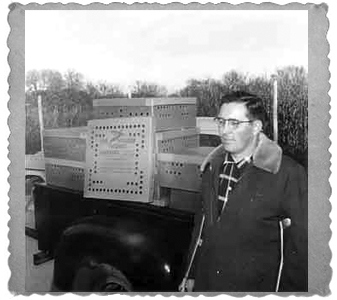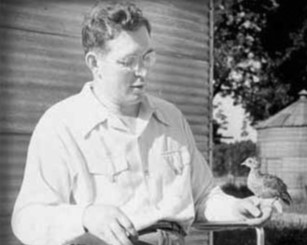History
Pheasants are not indigenous to the United States. The first pheasants were brought here from Great Britain in the late 1800’s and shipments of eggs continued to be brought here into the early 1900’s. It was soon discovered that pheasants thrived here. By the 1920’s pheasant populations were able to sustain hunting. Thus pheasant hunting became popular. In the late 1920’s there was a demand for pheasants for release and propagation.
Kenneth MacFarlane went to New York to attend a Game Rearing school. After completing the course, Kenneth returned to Wisconsin. In 1928, Kenneth imported eggs from Gaybird Game Farm in England. And in 1929, Kenneth formed MacFarlane Pheasant Farm. The pheasants were bred for sale to hunt clubs.
 Kenneth’s brother, Donald MacFarlane returned to Wisconsin in 1935 (Donald had been working as a chemical engineer for Standard Oil in New Jersey). Donald worked along side Kenneth in running the pheasant farm. In 1941 Kenneth was killed in a tragic hunting accident on the Mississippi River. Donald continued to operate the pheasant farm after Kenneth’s death. In 1946 Donald contracted polio, yet continued to operate the pheasant farm (though he was a paraplegic).
Kenneth’s brother, Donald MacFarlane returned to Wisconsin in 1935 (Donald had been working as a chemical engineer for Standard Oil in New Jersey). Donald worked along side Kenneth in running the pheasant farm. In 1941 Kenneth was killed in a tragic hunting accident on the Mississippi River. Donald continued to operate the pheasant farm after Kenneth’s death. In 1946 Donald contracted polio, yet continued to operate the pheasant farm (though he was a paraplegic).
The pheasant farm in the 1930’s was on the outskirts of Janesville, but as the City of Janesville grew, it found itself within the city limits by the 1950’s. In 1953 the farm was moved to its present location (about 1-1/2 miles south of its original location). Also during this time Donald’s brother-in-law, James Adamson joined the farm and coordinated the day-to-day farm operations.

During the 1960’s with the increased ability to ship day-old poultry nationwide, Donald expanded the breeding aspect of MacFarlane Pheasant Farm and began large-scale production of day-old pheasant chicks. Over 200,000 day-old pheasant chicks were produced annually during the 1960’s. During this same time frame dressed bird production was limited (perhaps 3,000 birds a year were produced). Also during the 60’s mature pheasants continued to be produced for sale to hunting preserves. About 200 acres of corn and soybeans were raised yearly. During the 1970’s Donald’s health declined and the farm sales began to decline somewhat. There was talk of the farm being sold in 1979. Donald persuaded his son Bill MacFarlane to return to Janesville and form MacFarlane Pheasants, Inc.
In the course of the early 80s Donald’s health declined further and James Adamson retired. In 1985, with the passing of Donald, Bill MacFarlane was now in charge of the operation.
In order to allow for expanded hatching capacity, a new hatchery was built in 1987. During this time of growth, pheasant pens were constructed yearly, and new brooder barns were erected. In 1988 another farm, one mile away, was purchased to be the hub of our breeding operation with new pens then erected at that location.
 In the late 1980’s the decision was made to enter into the dressed pheasant business. A commitment was made to produce fresh dressed pheasants every week of the year. In 1994, a state of the art genetic facility was constructed to enable the farm to focus on producing pheasants for meat more economically and efficiently. During the late 1990’s and into this new century, our focus has been to make the farm more efficient while continuing to be progressive and innovative in our approach. Teamwork and cooperation among our employees has become a top priority.
In the late 1980’s the decision was made to enter into the dressed pheasant business. A commitment was made to produce fresh dressed pheasants every week of the year. In 1994, a state of the art genetic facility was constructed to enable the farm to focus on producing pheasants for meat more economically and efficiently. During the late 1990’s and into this new century, our focus has been to make the farm more efficient while continuing to be progressive and innovative in our approach. Teamwork and cooperation among our employees has become a top priority.
Remembering Donald MacFarlane
Donald’s life was defined by perseverance, kindness, and an enduring commitment to family and community. As Kenneth, Donald’s oldest son, reflected, “He was such a positive person. I feel very fortunate that he was our dad.”
Today, MacFarlane Pheasants stands as a living tribute to Donald’s vision and values, inspiring future generations to carry forward his remarkable legacy.



